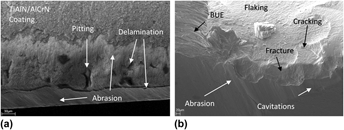Crossref Citations
This article has been cited by the following publications. This list is generated based on data provided by
Crossref.
Alabdullah, Mohanad
Polishetty, Ashwin
and
Littlefair, Guy
2016.
Impacts of Wear and Geometry Response of the Cutting Tool on Machinability of Super Austenitic Stainless Steel.
International Journal of Manufacturing Engineering,
Vol. 2016,
Issue. ,
p.
1.
Razak, Nurul
Chen, Zhan
and
Pasang, Timotius
2017.
Effects of Increasing Feed Rate on Tool Deterioration and Cutting Force during End Milling of 718Plus Superalloy Using Cemented Tungsten Carbide Tool.
Metals,
Vol. 7,
Issue. 10,
p.
441.
Ovcharenko, V. E.
Ivanov, K. V.
and
Mokhovikov, A. A.
2017.
Microstructure, tribological and strength properties of the surface layer in metal-ceramic composite nano-structured by electron irradiation.
Vol. 1909,
Issue. ,
p.
020162.
Yu, Bao-Hai
Ovcharenko, V. E.
Ivanov, K. V.
Mokhovikov, A. A.
and
Zhao, Yan-Hui
2018.
Effect of Surface Layer Structural-Phase Modification on Tribological and Strength Properties of a TiC–(Ni–Cr) Metal Ceramic Alloy.
Acta Metallurgica Sinica (English Letters),
Vol. 31,
Issue. 5,
p.
547.
Chandrashekar, M.
and
Sreenivasa Prasad, K.V.
2018.
The Effect of Cobalt on Wear behavior of Cemented Carbide cutting tools for machining of Titanium alloy.
Materials Today: Proceedings,
Vol. 5,
Issue. 2,
p.
7678.
Teng, Xiangyu
Huo, Dehong
Shyha, Islam
Chen, Wanqun
and
Wong, Eugene
2018.
An experimental study on tool wear behaviour in micro milling of nano Mg/Ti metal matrix composites.
The International Journal of Advanced Manufacturing Technology,
Vol. 96,
Issue. 5-8,
p.
2127.
Bandapalli, Chakradhar
Mohanbhai Sutaria, Bharatkumar
and
Vishnu Prasad Bhatt, Dhananjay
2018.
Titanium Alloys - Novel Aspects of Their Processing [Working Title].
Sheik Muhamad, Shalina
A. Ghani, Jaharah
Che Haron, Che Hassan
and
Yazid, Hafizal
2019.
Wear mechanism of a coated carbide tool in cryogenic machining of AISI 4340.
Industrial Lubrication and Tribology,
Vol. 72,
Issue. 4,
p.
509.
Ma, Jian-wei
Jia, Zhen-yuan
He, Guang-zhi
Liu, Zhen
Zhao, Xiao-xuan
and
Qin, Feng-ze
2019.
Influence of cutting tool geometrical parameters on tool wear in high-speed milling of Inconel 718 curved surface.
Proceedings of the Institution of Mechanical Engineers, Part B: Journal of Engineering Manufacture,
Vol. 233,
Issue. 1,
p.
18.
Montazeri, Saharnaz
Aramesh, Maryam
and
Veldhuis, Stephen C.
2019.
An investigation of the effect of a new tool treatment technique on the machinability of Inconel 718 during the turning process.
The International Journal of Advanced Manufacturing Technology,
Vol. 100,
Issue. 1-4,
p.
37.
Rakesh, Merugu
and
Datta, Saurav
2020.
Machining of Inconel 718 Using Coated WC Tool: Effects of Cutting Speed on Chip Morphology and Mechanisms of Tool Wear.
Arabian Journal for Science and Engineering,
Vol. 45,
Issue. 2,
p.
797.
Yu, Weiwei
Ming, Weiwei
An, Qinglong
and
Chen, Ming
2021.
Cutting performance and wear mechanism of honeycomb ceramic tools in interrupted cutting of nickel-based superalloys.
Ceramics International,
Vol. 47,
Issue. 13,
p.
18075.
Teng, Xiangyu
and
Huo, Dehong
2021.
Advances in Machining of Composite Materials.
p.
159.
Shankar, E.
Sampath Kumar, T.
Devanathan, C.
Giri Sankar, S.
Dhandapani, S.
and
Natarajan, M.S.
2021.
Comparative study of metallurgical and machinability characteristics of boronised and coated tungsten carbide inserts using EN19 steel as workpiece.
Materials Today: Proceedings,
Vol. 46,
Issue. ,
p.
3398.
Rajan, K M
Kumar Sahoo, Ashok
Chandra Routara, Bharat
and
Kumar, Ramanuj
2022.
Investigation on surface roughness, tool wear and cutting power in MQL turning of bio-medical Ti-6Al-4V ELI alloy with sustainability.
Proceedings of the Institution of Mechanical Engineers, Part E: Journal of Process Mechanical Engineering,
Vol. 236,
Issue. 4,
p.
1452.
Serebrennikova, A. G.
and
Savilov, A. V.
2022.
Proceedings of the 7th International Conference on Industrial Engineering (ICIE 2021).
p.
642.
Muhamad, Shalina Sheik
Ghani, Jaharah A.
Che Haron, Che Hassan
and
Yazid, Hafizal
2022.
Wear Mechanism of Multilayer Coated Carbide Cutting Tool in the Milling Process of AISI 4340 under Cryogenic Environment.
Materials,
Vol. 15,
Issue. 2,
p.
524.
Xu, Ziyang
and
Wang, Yongguo
2022.
Study on Milling Force and Surface Quality during Slot Milling of Plain-Woven CFRP with PCD Tools.
Materials,
Vol. 15,
Issue. 11,
p.
3862.
Halim, Nurul Hayati Abdul
Haron, Che Hassan Che
and
Ghani, Jaharah Abdul
2022.
PVD multi-coated carbide milling inserts performance: Comparison between cryogenic and dry cutting conditions.
Journal of Manufacturing Processes,
Vol. 73,
Issue. ,
p.
895.
Anurag
Kumar, Ramanuj
Sahoo, Ashok Kumar
and
Panda, Amlana
2022.
Comparative Performance Analysis of Coated Carbide Insert in Turning of Ti-6Al-4V ELI Grade Alloy under Dry, Minimum Quantity Lubrication and Spray Impingement Cooling Environments.
Journal of Materials Engineering and Performance,
Vol. 31,
Issue. 1,
p.
709.



